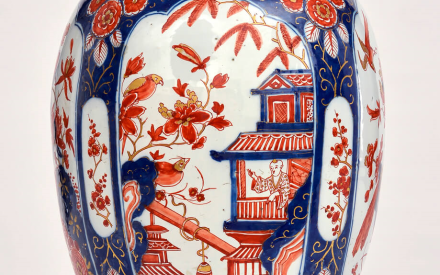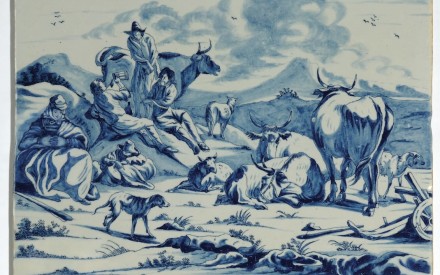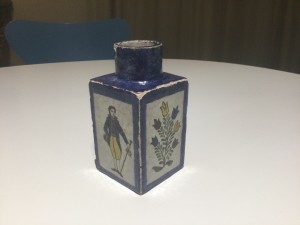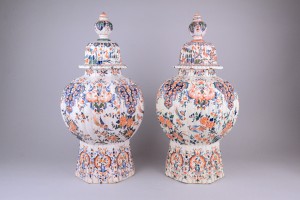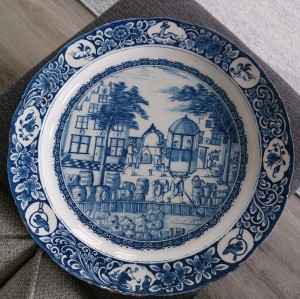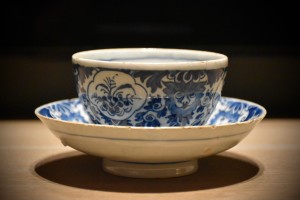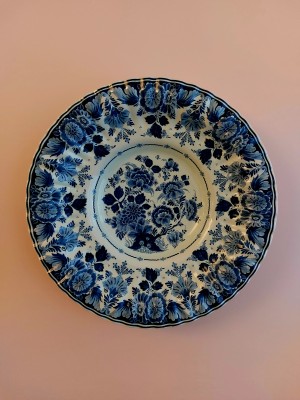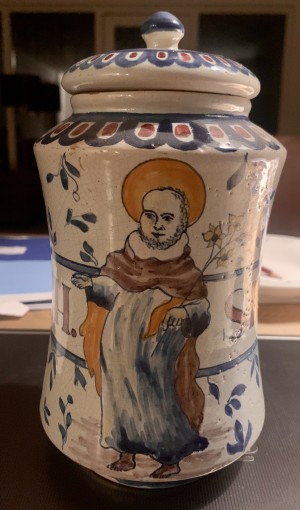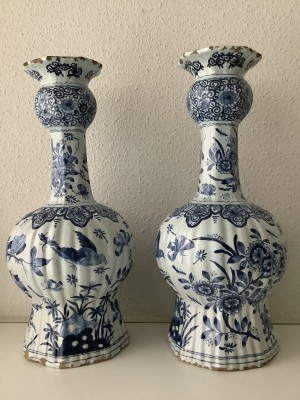Robert Aronson is de vijfde generatie eigenaar van het familiebedrijf Aronson Antiquairs. Deze Amsterdamse kunsthandel is gespecialiseerd op het gebied van Delfts aardewerk uit de 17de en 18de eeuw. Robert is daarnaast actieve bestuurder (geweest) bij verschillende kunst gerelateerde organisaties en is hij panellid bij het TVprogramma Tussen Kunst & Kitsch, als expert Europees aardewerk.
Publications
Last comments
Not Delftware
tulpenvaas
Verdict:
- Not Delftware
Analysis:
- Not made in Delft
- More recent production technique
- Forged mark
Dank aan dhr. Maes voor de juiste vaststelling. Het betreft hier echt een kopie van een 18e eeuws vaasjes, opvallend dat fabriek De Lampetkan (LPK) destijds een dergelijk vaasje nooit heeft gemaakt.
Not Delftware
Tea caddy or small vase
Verdict:
- Not Delftware
Analysis:
- Not made in Delft
- More recent production technique
Based on the images, I believe this piece was produced around 1900 at the workshop of Geo Martel in Desvres, France. His factory specialized in faience that imitated 18th-century Delftware, and your tea caddy has all the hallmarks of his production.
Best regards
Pair of 'cachemire' baluster vases
In reply to Dear Robert, Thank you very… by Adi
 Dear Adrian,
Dear Adrian,
Thank you for your response. While I appreciate your perspective, I have no doubt that these are not originals, nor do I question the dating. The key points of distinction lie in the coloration, decoration, shape (model), and the execution of the marks, all of which differ significantly from authentic 18th-century Delftware.
Regarding the production origin, the type of imitation seen here is consistent with pieces made in northern France around 1900. I have attached an image taken at the museum in Desvres, which houses examples of such imitations in the same color palette. These later copies often replicated Delft forms but differ in execution upon closer examination.
Best regards,
Robert
Not Delftware
Pair of 'cachemire' baluster vases
Verdict:
- Not Delftware
Analysis:
- Not made in Delft
- More recent production technique
- Forged mark
Unfortunately, these are not originals. The model initially raised concerns, but upon examining the details—thank you for sharing so many images—my first impressions were confirmed. The marks also appear rather ‘harshly’ drawn, which likely indicates they are intentional later imitations. While one can only make an educated guess, they were probably produced in northern France around 1900, during the peak of production in that region. You can find more information about an exhibition on various factories here.
Delftware
Bord
Verdict:
- Delftware
Analysis:
- Delftware, made between 1620 – 1850
- Tin-glazed earthenware
- Hand-painted
- Mark of a Delft pottery/factory
Merk:
- APK
As you may have gathered from the enthusiasm of our top users, this is a historically significant dish, with few equals. Not only is it marked for Pieter Kocx—or more precisely, his widow, Johanna van der Heul, who owned the De Grieksche A (The Greek A) factory from 1703 to 1722—but it also features a lively scene on the front. To top it all off, it is actually dated, and within Johanna’s period of ownership. The piece is of a beautiful size, and I particularly admire the stepped gable, the arch, and the gazebo. Thank you for sharing it on this platform—enjoy it!
Delftware
Kop en schotel met Flora van De Grieksche A - Pieter Kocx
Verdict:
- Delftware
Analysis:
- Delftware, made between 1620 – 1850
- Tin-glazed earthenware
- Hand-painted
- Mark of a Delft pottery/factory
Merk:
- APK
Ik zou graag de onderkant van het schoteltje nog zien, maar het eerste wat ik dacht was ‘wauw!’
Not Delftware
Schotel met bloemmotieven
Verdict:
- Not Delftware
Analysis:
- Not made in Delft
- More recent production technique
- Mark of a non-Delft pottery/factory
Dank aan Franky 😉
Not Delftware
Albarello
Verdict:
- Not Delftware
Analysis:
- Not made in Delft
- More recent production technique
- Forged mark
Dank aan Franky 😉
Not Delftware
Set vazen (knobbelvazen)
Verdict:
- Not Delftware
Analysis:
- Not made in Delft
- More recent production technique
- Forged mark
Dank aan dhr. Hartgers 😉
Delftware
Diepe ovale schotel met herten
Verdict:
- Delftware
Analysis:
- Delftware, made between 1620 – 1850
- Tin-glazed earthenware
- Hand-painted
- Unmarked
Inderdaad een slakom uit Delft, dank aan dhr. Maes. De slakom is waarschijnlijk al in de 19e eeuw gebroken en middels krammen weer aan elkaar gezet. Op onze website een leuk artikel over deze manier van repareren.

